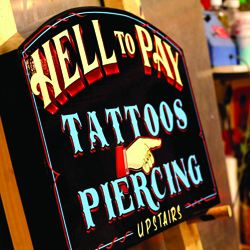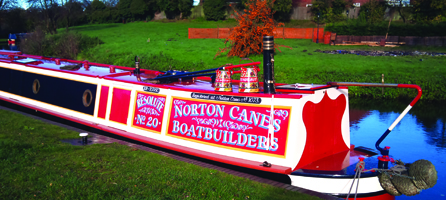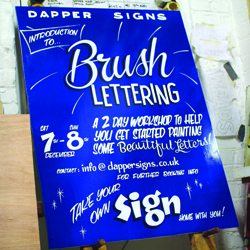
Internal, decorative neon signage has increased in popularity over the past few years, as companies look for unique signs with a vintage feel. Pictured: Bespoke sign from Neon Creations
A work of art
When it comes to the sign industry, however, demand is going back far further than the last 20 years. The shaded 3D lettering of Victorian shop fascias and the neon decorations of an American 50s diner are just two exam-ples of the styles experiencing a modern-day revival.
Yet with each generation becoming more reliant on digital technology, who is going to carry the torch and keep the traditional techniques alive? In this feature I speak to specialist sign-writers and sign-makers from across the generations that are committed to bringing these much-loved antiques into the 21st Century and beyond.
Name in lights
Illuminated signage is unlikely to immediately spring to mind when we talk about traditional techniques, yet neon has been around for over a century. One firm that appreciates the importance of passing skills down the generations is family-run company Neon Creations. Sales and marketing director Catherine Spink explains how a solid grounding in the a traditional craft was the first step in the formation of the business: “Our company was established in 2005, after our prod-uction director had been glass bending for 16 years, starting as an apprentice. We thought the time was right to set up our own company, so that he could start creating some of the different ideas he had.”

(Above and below) the majority of Neon Creations’ commissions are for internal, decorative signage, an area that is particularly subject to the changing demands of fashion
In turn, the firm has devised its own training and grading programme to ensure other young people have the opportunity to pick up the craft, and currently have a trainee learning on the job. Neon Creations mainly supplies internal signs, meaning much of what it does is for decorative and artistic purposes, as well as a fewer number of internal advertising signs for shops, restaurants, and bars. By its nature, decorative signage is particularly subject to shifting fashions, as Spink explains: “If you are talking about internal advertising signage, then the demand has probably stayed constant, but demand for neon lighting for art and decorative purposes has increased over the last couple of years.
“Neon is truly unique, in that the light is more vibrant than other forms of illuminated signage. Neon signs just have more impact.”

Neon is truly unique, in that the light is more vibrant than other forms
of illuminated signage. Neon signs just have more impact”
Yet it is not entirely positive news for the classic techniques, as Spink goes on to say she believes demand for external neon signage has declined in recent years. And there is no denying that working with older materials and processes comes with its challenges; Spink suggests the design of the sign is all the more important when working with neon.
She continues: “The tricky thing is making it look like it’s intended. If we don’t think a given design that we are supplied will translate well into neon, then we will advise the client, rather than making it and it not looking good. In our opinion, there is nothing worse than a bad looking neon sign.”
This is a key attribute of the firm, as all its design and manufacturing is undertaken in-house. On top of this, the team at Neon Creations are clearly passionate about the survival of the craft, as Spink concludes: “If it’s not broken, why try and fix it? Neon has been around for a century with little if anything changing in the way that it is made. It clearly works. What other manufacturing industries can say they haven’t changed the process in a 100 years?”
Looking dapper
It is not only those who have been in the trade for years that are committed to prolonging the life-span of traditional signage; there are many examples of the younger generation working to keep the classic techniques alive.
Bristol-based Dapper Signs exclusively uses hands, brushes, and paint to produce custom-made, bespoke signs. As its website claims: “If it stays still long enough, we can paint it!”

James Cooper of Dapper Signs putting the finishing touches to a hand-painted, restaurant
window sign
James Cooper founded the company in 2005, after falling into sign writing through an unconventional route.
“I was working on bars and food stalls at Glastonbury, and they all wanted menus and signs written; I offered mainly to skive off work,” he reveals.
After deciding sign writing was the career for him, Cooper looked locally for some formal training or advice, but found it lacking: “I would have loved to take a training course when I first started out, or have had some guidance,” he say, before adding: “But I couldn’t find anything—other companies I approached didn’t have the time or capacity to help.”
With this in mind, Cooper is running an Introduction to Brush Lettering workshop, a two-day course aimed to give hopeful sign-writers a grounding in the techniques and skills required.
Despite the initial lack of support Dapper Signs has evolved into a successful local business; Cooper began by bombarding Bristol with business cards, built up a reputation, and now receives most of his business from word of mouth. Yet he also puts his youth and knowledge of social media to good use, using the most modern technology to promote his traditional craftsmanship.

James Cooper is working with a tattooist from Peterborough who found Dapper Signs via Instagram
“Instagram has been really important to us,” he explains, adding: “We’ve even had a job in New York that came about after the owner saw examples of our work on Instagram. We’re curr-ently working with a tattooist in Peterborough who found us in the same way. It’s a great way to get work outside of our local area, where people can see our work in real life.
“Demand is growing year-on-year; as the economy is improving and people have a bit more money, we’re receiving more enquiries. The business is growing, and we’re planning to move into larger premises.”
And as this growth continues, Cooper pledges to invest back into the industry, by taking on trainees and aiding the longevity of traditional signage: “We get a lot of inquiries about taking on apprentices, and now that we’ll have more space, we can finally do it.”
Sailing forward
Now we move to a sign-writer of a different nature. Dave Moore, founder member of the Waterways Craft Guild is a veteran of narrow boat sign writing, as well as traditional rose and castle painting.
He explains: “How I got into this narrow boat and sign-writing business is a long story. The grammar school I went to back in the early sixties owned a canal boat. Shortly afterwards I got to know a man called Malcolm Brain, who brought his ex-working boats to the same boatyard. Malcolm opened my eyes to a wider waterways horizon than just being part of a school boat crew—I regard him as my mentor.

Dave Moore is a founder member of the Waterways Craft Guild and a veteran of narrow boat sign writing. Pictured: Moore’s own narrow boat hand-painted by himself
“One weekend a Black Country sign-writer came to put the lettering on one of Malcolm’s boats, and something went click. This was really the beg-inning of it, and I’ve been interested ever since.”
Moore began his sign-writing career over thirty years ago, initially on a part-time, then a full-time basis, and is keen for the craft to continue after he hangs up his brush.
He continues: “I must have taught hundreds of people the art of narrow boat painting over the years and take occasional sign-writing weekends, where I introduce students to basic alphabets and we look at techniques of shading, spacing, and layout.
“Initially you need a sound know-ledge of these. You can get away with indifferent lettering if its well spaced. No matter how beautifully the letters are painted, if it’s badly spaced it won’t look right.”
Moore has never had any formal training himself, but is keen to create opportunities for those who would like to learn the craft.

I’ve got a very solid background in old working boat liveries—just from
being around the things for the last 50 years. I never consciously
learned how to do it; I just absorbed it by osmosis”
“I’ve got a very solid background in old working boat liveries—just from being around the things for the last 50 years. I never consciously learned how to do it; I just absorbed it by osmosis. I am one of the founder members of the Waterways Craft Guild; we set this up to preserve and pass on the knowledge. I am moderately passionate about it, or as passionate as an old man can get.”
O Factoid: The first neon sign was installed in 1913, when a large sign for the vermouth Cinzano illuminated the night sky in Paris O
Of course the major drawback of traditional sign-writing techniques is the time that it takes; Cooper of Dapper Signs points to the firm’s inability to compete with the turnaround time of vinyl shops as one of the greatest challenges it faces.

Dapper Signs founder James Cooper now runs
an Introduction to Brush Lettering workshop for
people wanting to learn
Moore acknowledges the benefits of modern technology, but highlights the unique attributes of his chosen craft.
“I can’t paint letters as accurately as a computer programme can print and cut them,” he begins, adding: “But what a computer can’t do is all the infinitesimal little tweaks that make lettering look right.
"Letters are subtle little beasts, you only have a fraction of an inch either way before you go from something worthwhile to something less so.”
He continues: “Most sign-writers take a standard printers font and they modify it personally. They do this unconsciously, not necessarily to make a statement.
"This is why my work is recognisable; I’ve lost count of the customers who I’ve met up with some time after painting their boat, who say: ‘I was in London or Manchester or Coventry and I saw a “Dave Moore” boat’. I can look at the work of a lot of painters and be able to identify who it was.”
This clearly has its benefits for a business; Moore has never spent a penny on advertising: “The work finds me. And these days, now that I’m of a certain age, I tend to work for regular customers only, on commissions that really interest me.”
Whilst there is no getting away from the digital direction our world is moving in, there are some aspects of the past worth holding onto. Modern techniques are evolving the sign industry at an incredible rate, but with the number of committed advocates of traditional signage doing all they can to pass on knowledge, the old skills seem destined to survive for generations to come.
gggg